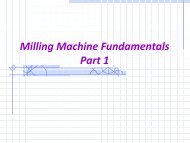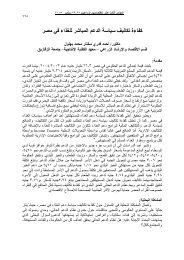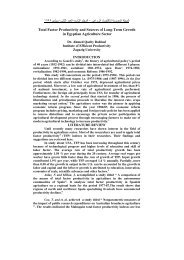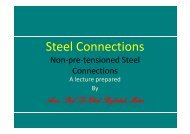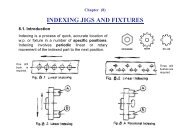ICFDP9-EG-281 - Zagazig University Staff Home Page
ICFDP9-EG-281 - Zagazig University Staff Home Page
ICFDP9-EG-281 - Zagazig University Staff Home Page
You also want an ePaper? Increase the reach of your titles
YUMPU automatically turns print PDFs into web optimized ePapers that Google loves.
optimum one (i.e S = 0.35), the gross cross section area of the<br />
movable bed becomes greater than the previous case, however<br />
the net one is still small. Actually, there is an weak zone formed<br />
just DS of the sudden expansion. It extends to big distance. As a<br />
result, the actual flow velocity over the movable bed is still<br />
large. Consequently, the scour process is still critical, see Fig.<br />
(4c). In case of cross section of optimum side slope S (i.e S =<br />
0.29), the interaction between the guide walls and cross section<br />
slope controlled the weak zone formed just DS of the sudden<br />
expansion, see Fig. (4b). Actually, the net cross section area of<br />
the movable bed becomes greater than the previous case. It<br />
leads to reduce the actual flow velocity over the movable bed is.<br />
Consequently, the scour process is clearly minified, see Fig.<br />
(4b).<br />
ESTIMATION OF MAIN SCOUR PARAMETERS<br />
Using all the experimental data of the relative scour depth<br />
and the relative protection length, a prediction models were<br />
developed and verified using the multiple linear regression<br />
analysis, as follows:<br />
d s<br />
y1 = 1.1029 + 0.0880 F1<br />
- 2.2719 S<br />
(3)<br />
L s<br />
y1 = 4.512 + 0.4160 F1<br />
-10.2877 S<br />
(4)<br />
Figures (5a,b) show a comparison between the measured<br />
d s /y 1 and L s /y 1 and the predicted ones using Eqs. (3) and (4),<br />
respectively and an acceptable agreement can be noticed, to some<br />
extent. The residuals of the previous equations are plotted<br />
versus the predicted values as shown in (6a,b). The residuals<br />
show random distribution around the line of zero. The<br />
regression statistics have been listed in the table (1).<br />
Table (1): The Regression Statistics<br />
Regression Statistics Eq. (3) Eq. (4)<br />
Multiple R<br />
R Square<br />
Adjusted R Square<br />
Standard Error<br />
Max. R. Absolute<br />
error<br />
Average R. Absolute<br />
Error<br />
0.934<br />
0.873<br />
0.867<br />
0.106<br />
0.34<br />
0.089<br />
0.950<br />
0.903<br />
0.899<br />
0.422<br />
0.506<br />
0.099<br />
CONCLUSIONS<br />
An experimental study was carried out to control the scour<br />
activities DS of the vertical gate using a modified guide walls in<br />
a trapezoidal cross section channel. The conclusions of this<br />
study may be presented as follows:<br />
• It was found that the different scour parameters ds/y 1 and<br />
Ls/y 1 increase as F 1 increases,<br />
• Generally, it was found that the guide walls minified the<br />
different scour parameters compared to the no-guide wall<br />
case,<br />
• Generally, it can be said that, the cross section of side<br />
slope S = 0.29 at presence of guide walls ((b o /b =0.31, and<br />
t/b =3.1%) reduced the relative scour parameters to<br />
minimum limit within the experimental range of the study.<br />
• The results of the proposed empirical equations are<br />
compared to the experimental measurements and an<br />
acceptable agreement has been found within 10% average<br />
absolute relative error.<br />
NOMENCLATURE<br />
b clear stilling basin width [L]<br />
b o length of opening in the guide wall [L]<br />
d s maximum scour depth [L]<br />
F 1 initial Froude number [- ]<br />
G gate opening [L]<br />
H U US water depth [L]<br />
L b stilling basin length [L]<br />
L s maximum protection length [L]<br />
S cross section side slope [- ]<br />
t guide wall thickness [L]<br />
V 1 mean velocity at the initial depth [LT -1 ]<br />
y 1 initial depth of hydraulic jump [L]<br />
y 2 sequent depth of hydraulic jump [L]<br />
α deflection angle of guide walls [degree]<br />
ρ water density [ML -3 ]<br />
ν kinematics' viscosity [L 2 T -1 ]<br />
REFERENCES<br />
[1] A.M. Negm, “Effect of sill arrangement on maximum scour<br />
depth DS of abraptly enlarged stilling basins”, Proc. Of Int.<br />
Conf. Hydraulics of Dams and River Hydraulics, 26-28<br />
April 2004, Tehran, Irn. 2004.<br />
[2] A.M. Yassin, S.A. Zein, S.T. E1-Attar, and M. E1-Dardeer,<br />
“Effect of method of water regulation on the scour below<br />
regulators” Bull. of Fac. of Eng., Assuit Univ., Vol. 23, No.<br />
2, pp. 1-10, July, 1995.<br />
[3] C.D. Smith, and N.G. Yu, “Use of Baffles in Open Channels<br />
Expansion”, Journal of The Hydraulic Div., ASCE, HY2,<br />
March, pp.1-17, 1966.<br />
[4] D. Yildiz, and E. Uzucek, “Prediction of Scour Depth<br />
from Free Falling Flip Bucket Jets”,Intl. Water Power<br />
and Dam Construction, 1994.<br />
[5] G.M. Abdel-Aal, M.M. Elfiky, A.M. Negm, and M.A.<br />
Nasser, “Effect of Management and Operation on Scour<br />
Characteristics Ds of Multi Vent Regulators”, Sc. Bull., Fac.<br />
of Eng., Ain Shams Univ., Vol. 39, No. 4, pp. 385-400, Dec.,<br />
2004.<br />
3 Copyright © 2008 by ASME




